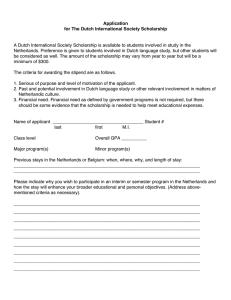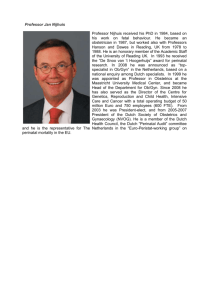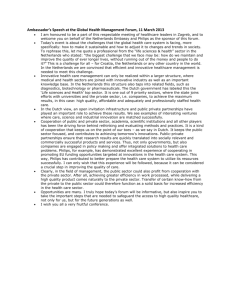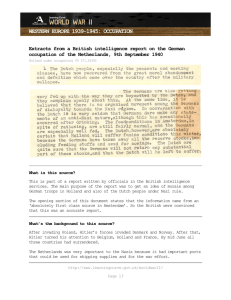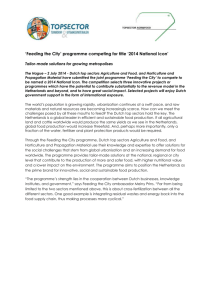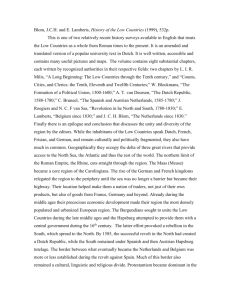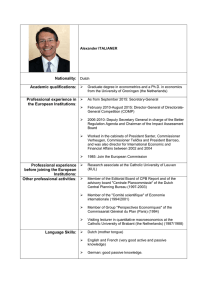Submission for general comment on the rights of the child...
advertisement
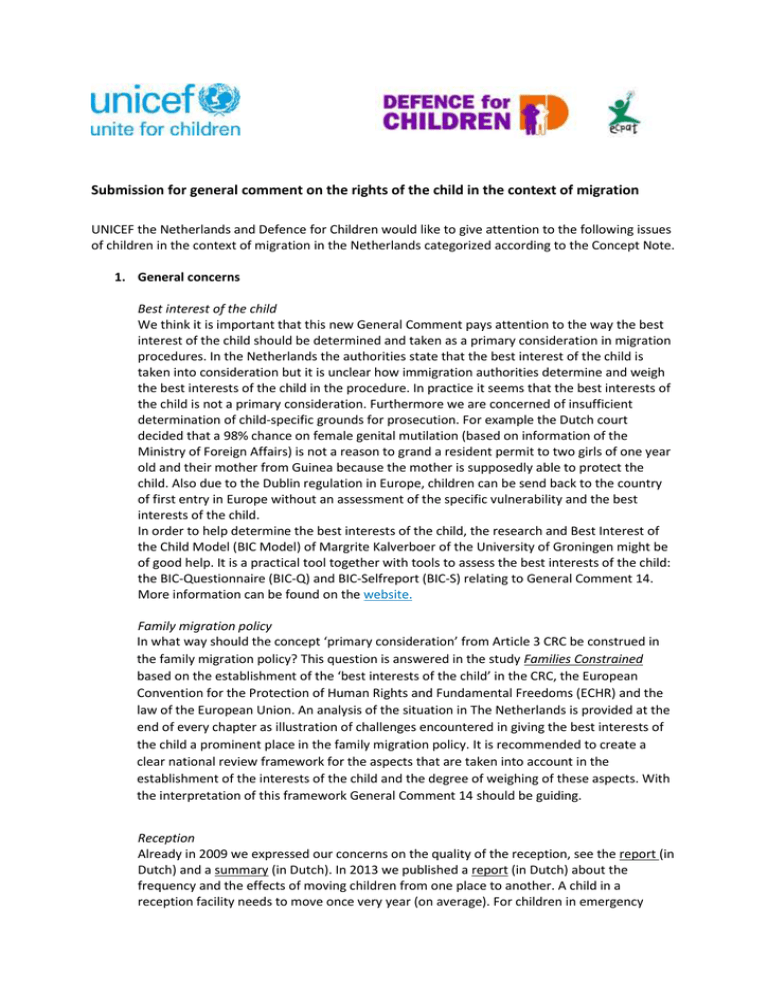
Submission for general comment on the rights of the child in the context of migration UNICEF the Netherlands and Defence for Children would like to give attention to the following issues of children in the context of migration in the Netherlands categorized according to the Concept Note. 1. General concerns Best interest of the child We think it is important that this new General Comment pays attention to the way the best interest of the child should be determined and taken as a primary consideration in migration procedures. In the Netherlands the authorities state that the best interest of the child is taken into consideration but it is unclear how immigration authorities determine and weigh the best interests of the child in the procedure. In practice it seems that the best interests of the child is not a primary consideration. Furthermore we are concerned of insufficient determination of child-specific grounds for prosecution. For example the Dutch court decided that a 98% chance on female genital mutilation (based on information of the Ministry of Foreign Affairs) is not a reason to grand a resident permit to two girls of one year old and their mother from Guinea because the mother is supposedly able to protect the child. Also due to the Dublin regulation in Europe, children can be send back to the country of first entry in Europe without an assessment of the specific vulnerability and the best interests of the child. In order to help determine the best interests of the child, the research and Best Interest of the Child Model (BIC Model) of Margrite Kalverboer of the University of Groningen might be of good help. It is a practical tool together with tools to assess the best interests of the child: the BIC-Questionnaire (BIC-Q) and BIC-Selfreport (BIC-S) relating to General Comment 14. More information can be found on the website. Family migration policy In what way should the concept ‘primary consideration’ from Article 3 CRC be construed in the family migration policy? This question is answered in the study Families Constrained based on the establishment of the ‘best interests of the child’ in the CRC, the European Convention for the Protection of Human Rights and Fundamental Freedoms (ECHR) and the law of the European Union. An analysis of the situation in The Netherlands is provided at the end of every chapter as illustration of challenges encountered in giving the best interests of the child a prominent place in the family migration policy. It is recommended to create a clear national review framework for the aspects that are taken into account in the establishment of the interests of the child and the degree of weighing of these aspects. With the interpretation of this framework General Comment 14 should be guiding. Reception Already in 2009 we expressed our concerns on the quality of the reception, see the report (in Dutch) and a summary (in Dutch). In 2013 we published a report (in Dutch) about the frequency and the effects of moving children from one place to another. A child in a reception facility needs to move once very year (on average). For children in emergency reception locations this number is even higher. The Dutch authorities took over some of the recommendations, but there are still concerns for example about the frequency of moving, about the right to health care, the right to play, the right to privacy, the right of participation. Practice shows that the State does not always recognizes the special care for mental or physically disabled children. We realize that due to the number of asylum seekers that entered the Netherlands, the Dutch government is struggling to arrange reception. However, the 2009-research shows that current problems already exist for years. We therefore emphasize the importance to underline the obligations of the State in relation to migrant children in this new General Comment. Psychosocial support should be specifically included in the care for refugee children. It is essential that children receive education as soon as possible and without any financial barriers. Schools should not have financial barriers to accept refugee children and children should not have financial barriers, for example, in transport to the school. The quality of the education should be the same as for other children in the country. In the Netherlands Augeo Foundation created an online tool (in Dutch) for teachers of refugee children. 2. Migrant children that return to their country of origin, either voluntarily or by force, alone or with their parents Child Notices To decide if children can return to their country of origin the Dutch authorities use country of origin reports (COI). These reports do not include specific information about the living conditions of children in their countries of origin. This information is indispensable in asylum procedures in which children (and their parents) are involved or in other procedures considering the best interests of the child such as those designed to provide protection to trafficked children. The reports are essential for determining whether there are child-specific grounds for prosecution, and whether it is in the best interest of the child to stay or return to the country of origin. When it is decided that the child has to return to their country, it is important to have a clear view of the situation which the child will return to. UNICEF National Committees in the Netherlands, Belgium and Sweden, worked on the development of child-specific country of origin reports (COI), on five countries Morocco, Albanië, Afganistan, Sudan and Guinea. These country reports (Child notices) describe the situation of children in countries of origin of migrant children. This includes legal and practical information on education, health care, child protection, armed conflict, juvenile justice, trafficking etc. These Child Notices are meant to provide more information about the position of children who have fled or have been trafficked to Europe. The Child notices are available at the website. Monitoring of Returned Minors The Monitoring of Returned Minors (MRM) project aims to contribute to more sustainable and safer return of minors. The project has developed a monitoring model for the return of minors, based upon the United Nations best interest of the child criteria. More information is available at the website. The monitoring model could be useful as a tool for other countries. Detention In 2014 we, together with other organizations, published a report (in Dutch) on immigration detention in the Netherlands. The report showed the negative impact on child health and development. We think it is important that the General comment states that children should not be detained based on their residency status. The Dutch authorities confirmed that it will not apply ‘border detention’ to children when their entry has been refused. However children can still be detained for purposes of deportation. It is unclear how authorities weight the best interest of the child in detention decisions. In several Dutch cases the court decided that the detention of children for purposes of deportation was not necessary. 3. Children that migrate unaccompanied and separated from their parents (for reasons such as seeking employment, family reunification or as victims of trafficking, labour exploitation and child labour) Disappearance of unaccompanied migrant children Disappearance of unaccompanied migrant children should be taken seriously. Next month the SUMMIT project will publish a research on how the issue of disappearances of unaccompanied migrant children is addressed in different countries and to promote successful strategies and attitudes related to the prevention and response to these disappearances. Some results are already published. Durabable solutions for seperated children in Europe Children need support and consistency in order to overcome traumatic experiences, including those experienced in the country of origin, in transit and in the country of arrival. Children also have the right to be heard and have their views taken into account to determine their best interests in respect of assessing and implementing a durable solution. It is therefore crucial that European Member States have adequate procedures in place to develop a care plan that incorporates a durable solution. This care plan should take into account the views of the child and assess any risk factors at the outset and continually review this plan as the child matures and their circumstances change. The project Durable Solutions for Separated Children in Europe was undertaken with the aim to identify and recommend best practices in determining and implementing durable solution for separated children in Europe. More information and the European and national reports can be found on the website. Core standards for guardians Proper guardianship systems are essential to assist in finding a durable solution for separated children, whether that be integration into the host country, transfer to another country or return to the country of origin. Defence for Children developed core standards for guardians, available on www.corestandardsforguardians.com. The Core Standards are referred to in the FRA Handbook and a motion has been adopted at the Council of Europe which calls for the Core Standards to be used as a monitoring mechanism. Age Assessment Common standards are needed so that age assessment respects children’s rights and in order to provide appropriate safeguards to the individuals whose age is being disputed, prior to and throughout the whole procedure. See for further information a paper of Separated Children in Europe Programme and a publication of the European Asylum Support Office. Child Trafficking in the Netherlands Report concerning the implementation of the Council of Europe Convention on Action against Trafficking in Human Beings by the Netherlands see also a Dutch report on Child Trafficking in the Netherlands.

